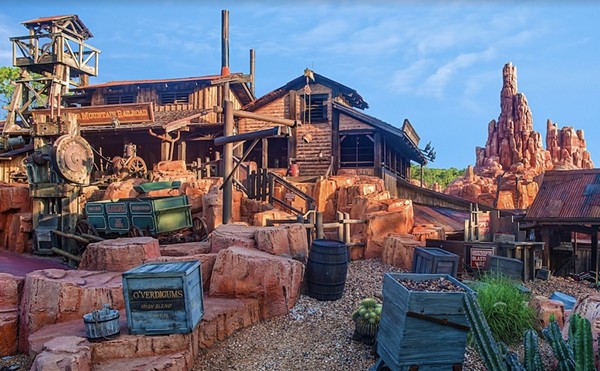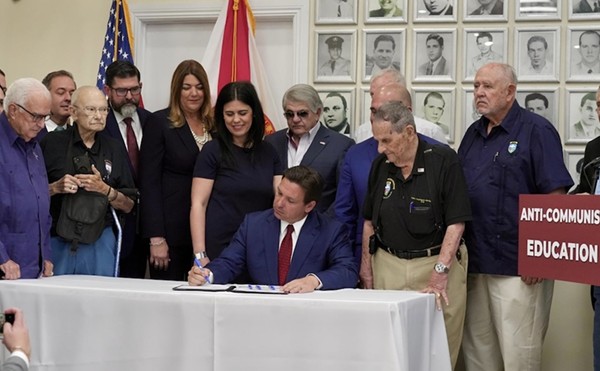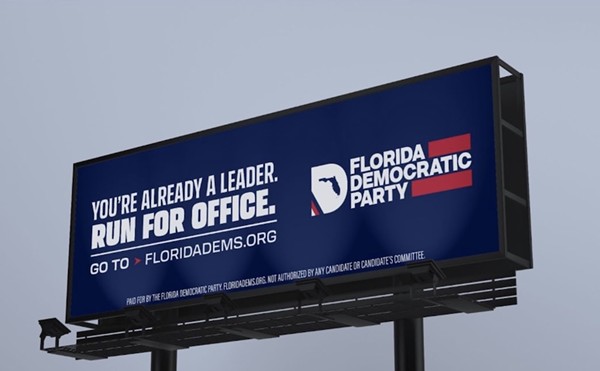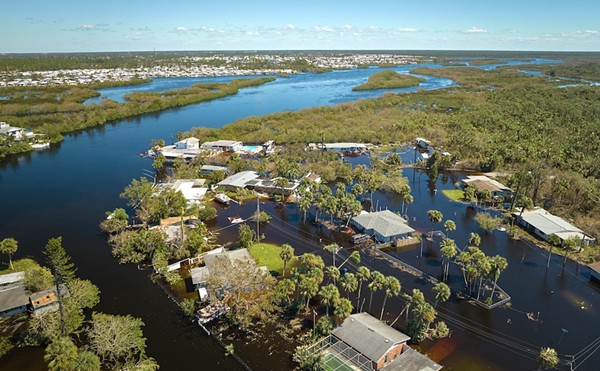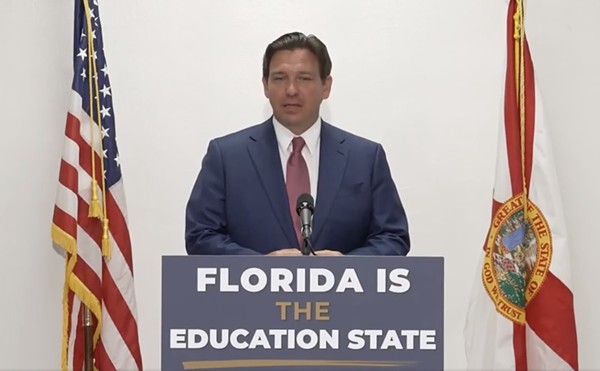Big ideas bring big talk, the kind that can buzz around one's head without landing. And there will be a lot of talk this year by the city's movers and shakers, what with the unexpected replacement of Mayor Glenda Hood a year before her term was up, thanks to Gov. Jeb Bush's higher calling, as well as economic uncertainties at large. There are too many civic needs and not enough money to fund them -- so what else is new? But to help sharpen the listening skills of the average citizen -- and remember, what you don't hear is just as important as what is being said -- we've summarized five compelling issues that will shape, in one way or another, the present and near future of Orlando. Acquaint yourself with these areas of activity, and the puzzle of politics and policy should start coming together for a clearer picture of the necessary action. If we, the taxpayers, don't know what's needed, then how can we hold our leaders accountable?
New mayor: Change is good
On Feb. 4, Orlando voters will pick the first new mayor of The City Beautiful in a decade. And this town desperately needs a breath of fresh air. Mayor Glenda Hood's reign has seen a few successes, mainly the revitalization of downtown neighborhoods. But there were also considerable failures: Parramore is still a mess; downtown businesses are limping, thanks in part to Hood's effort to drive out anything not deemed family-friendly; there's no theater district to speak of and no performing arts center; and the city council is often divided into bitter factions.
All of which offers the next mayor the chance to snag the much sought-after legacy Hood couldn't obtain: a vibrant downtown of theaters, restaurants, retail shops, and bars and clubs that don't open, close, reopen with new owners and close again.
Here are some practical ways to reach that goal.
First, focus on affordable housing downtown. In general, more affordable housing is always good -- the massive, Hood-pushed Baldwin Park development, for instance, has none -- but nowhere is that more true than downtown. More affordable housing means more younger people downtown, and these younger people are the most likely to shop, eat and party on Orange and Magnolia avenues.
Second, look again at how the city's Community Redevelopment Agency dollars are spent. The Downtown Development Board has hoarded the money -- part of which is diverted from Orange County coffers to ostensibly counter "blight" -- for high-end apartments, restaurants and hotels on the east side, while the beleaguered Parramore neighborhood begs for middle-income housing and commercial development. Those east-side developments are needed, but it's easy to argue that the west side is far more "blighted" and in need of the CRA's help.
Third, lay off the homeless. Hood cracked down on where they could stand, sit and sleep. She kept social service groups on the west side from expanding. She even tried to keep The Ripple Effect from feeding the homeless in Lake Eola Park. Instead of the sweep-the-vagrants-under-the-rug approach, the next administration must proactively address the problem and work with The Ripple Effect to set up phone banks and post-office boxes for the homeless to help get them on their feet.
Fourth, when the Sentinel talks again about consolidating city and county governments, tell the daily to stuff it. The city desperately needs to cultivate a young, urban feel. Orange County is suburban, sprawling and frankly, a bit square. The two don't mix. Cooperation must be encouraged, and having a mayor without Hood's divisive personality will help. But the city and county are different entities, and they need different leaders.
Last, ditch Hood's moral crusade. Extend drinking hours downtown, so the bars can thrive and compete with Downtown Disney and Universal's CityWalk. Encourage a cutting-edge atmosphere. Help downtown create an identity, even if it's not one that churches or country clubs endorse. That what's draws people downtown.
Of the eight mayoral contenders, three stand out as most likely to win -- Buddy Dyer, Bill Sublette and Tico Perez. To some degree, they're cut from the same mold. Dyer's a moderate Democrat, the latter are moderate Republicans. All demur from saying anything negative about the Hood administration. All are lawyers who've run for various state offices.
But there are also key differences: Sublette banks on the "family-friendly" vote, and that's not good for downtown. Dyer speaks in vagaries, though he's the most progressive on nightlife issues and is pushing a living wage for city employees and contractors. Perez, in contrast, gives detailed, specific answers to questions on Parramore, the homeless and affordable housing, but he doesn't see the need for either extended drinking hours or a living-wage ordinance.
The good news: No matter who wins, Orlando sees change. The better news: If the winner blows it, there's still the regularly scheduled mayor's election next year.
— Jeffrey C. Billman
Downtown: The changing color
In 1939, Orlando's white population protested the fact that the city's first black community was located among white neighborhoods. So city leaders forced blacks in Jonestown to move into the Griffin Park Housing Project on Orlando's west side. Jonestown's shacks were torn down and turned into what we now call Reeves Terrace.
White leaders have been bulldozing Orlando's black neighborhoods ever since. Blacks were forced to move from their homes for the East-West Expressway, the Orlando Arena (now the TD Waterhouse
Centre) and the John Young Parkway expansion. Now the target is a four-acre residential redevelopment that has yet to be built in the heart of Parramore and is part of a land grab by the Carolina-Florida development company.
Last month, 45 black families discovered they'd be relocated for the city's $30 million police-fire headquarters, which will begin construction in 2004 in Parramore. Those low-income families at least had advance notice. Parramore, the mile-long, low-income community west of I-4, will almost certainly become the site of the next Orlando gold rush as property values soar because of high-dollar development.
Spurring that growth is the $59 million, eight-story office-retail-residential complex at Church and Division streets, which many people expect will do for Parramore what Winter Park Village has done for the west side of Winter Park: Give it an identity that attracts more builders.
The Hughes Supply Square, as the in-progress enterprise is called, dwarfs every commercial development in Parramore. It will contain 198,000 square feet of office space, 2,500 square feet of retail, 1,000 parking spaces and 266 one-, two- and three-bedroom apartments, 106 of which will be set aside for low-income residents. The corporate offices are expected to be completed by June 30 and the apartments by July 31.
By next year, three more major projects will break ground in Parramore -- the long-anticipated Florida A&M Law School, the $65 million U.S. Federal Courthouse and the police-fire headquarters, which has been named the Public Safety Complex. By that time, the gentrification of the neighborhood should be fully underway, whether city leaders are prepared or not (with most observers guessing they won't be).
Yet Parramore's revitalization still pales in comparison to Orlando's east side. A new $29 million transit station will break ground later this month at Garland and Amelia streets, which will contain 2,400 square feet of retail space, a six-story office tower, a terminal that will hold 24 bus bays, and future connector plans for the high-speed train and light rail (see Transportation.)
An 18-story condominium, The Sanctuary, is expected to break ground, possibly late this year, at Eola Drive and Pine Street. And in the area north of Colonial along Orange Avenue, two developments -- the $30 million, seven-story, mixed-use Uptown Center and the $25 million, 10-story Remington Apartments -- should be completed within a year.
At the center of downtown's east side, a flashy proposal has been an-nounced for the construction of the Tower on Church Street, a $40-million high-rise that, at 30 stories, will be among Orlando's tallest buildings. Preliminary plans call for the tower to have 250 apartments, 30,000 square feet of retail space and a seven-level parking garage. Best of all, nobody will have to be evicted to build it: The tower is expected to consume the old Jaymont block, the stretch of vacant stores where Terror on Church Street operated for several years.
As downtown Orlando's height and girth continue to break records, watch for poor minorities to continue to be pushed aside. City leaders are great at building and creating wealth, but their track record of displacing minorities ranks near the bottom in sensitivity and ethics. Affordable housing is the only remedy.
— William Dean Hinton
Cultural tourism:
A vague road map
Just as the federal government is unable to confront any problem without declaring "war" on it, greater Orlando can't seem to embrace an undertaking that doesn't define itself as tourism. The latest variant of that ideological fixation, "cultural tourism," is a catchphrase that deserves serious scrutiny in the months ahead, embodying as it does the guiding principle of Orange County's campaign to jump-start the local arts.
Briefly stated, that principle asserts that the area's cultural endeavors can play an important role in attracting out-of-town guests -- and that they'll have to, if they want monetary subsidies. Last November, for example, the county doled out $471,482 in grant monies to four organizations -- Orlando Museum of Art, Zora Neale Hurston Festival, Florida Film Festival and Orlando International Fringe Festival -- that had demonstrated their ability to draw visitors from 50 miles away or more.
To lawmakers, the criterion was only logical: The money had come from tourist taxes in the first place, so it had to be spent on initiatives that would return the investment by stimulating hotel/motel stays and other tourism-related expenditures. But to many area residents, the ongoing give-and-take raises a number of questions, from the procedural to the philosophical.
Will it work? On its face, cultural tourism appears to depend on the idea that venues like theaters and art galleries can compete with the attractions for visitors' dollars. When viewed within the context of the current tourist base, that's a hard image to sustain. According to Terry Olson, the county's Arts & Cultural Affairs administrator, the agenda is instead to attract a "different kind of tourist" who places a high priority on enriching offerings and is willing to cross great distances to seek them out -- a soft economy and airline-safety qualms notwithstanding.
That model is supported by Alan Parter, a Manhattan-based consultant who has helped communities such as Philadelphia, Mexico City and Alexandria, Va., enhance their tourist standing. (A recent project: Baltimore.) Parter says that cultural tourism is one of the fastest-growing categories in the business. But he doesn't discount more traditional vacationers, who he says can often be convinced to extend their stays by a day or two in order to attend an arts-related event. What that requires, of course, is drawing guests who have appetites for both Mickey and Moli´re.
Is it fair? On the surface, it's hard to argue against giving money to distinguished community resources like the Hurston affair or the Florida Film Festival. They have long histories of serving the public good. What's missing from the picture -- at least for now -- is a sense of how smaller, more artistically obscure groups will fare. To "prove" their tourist appeal, Olson says, the winners of the November grants pulled out such PR tools as press notices they had earned in other cities. One wonders where that leaves artists and organizers who, unlike the Hurston folks, have fallen below the radar of The New York Times.
An answer may be found in the upcoming announcement of $28,418 in "micro-grants" (up to $1,500 each). It will be interesting to learn how the (presumably less pedigreed) winners were able to demonstrate cross-geographic appeal. A factor in their favor: Olson, who came to his current position from the Central Florida Theatre Alliance, has a long and commendable history of supporting the tiniest, most "niche" arts-related initiatives.
What are the side effects? What bothers some observers the most about the cultural-tourism push is its implied intrusion on creative freedom -- the feeling that, in the words of one seasoned arts professional, "the powers-that-be are telling you what kind of art you have to create and how you have to market it." To get in on Orange County's largesse, will cultural groups feel compelled to dilute their work until it's salable to a general audience? Does community-specific art go out the window?
Olson says he would love to be able to hand out money "that was not as structured in its use." But he stresses that the program is a comparatively small element of arts funding. Groups who don't wish to pursue tourist audiences, he says, are free to go elsewhere for their subsidies.
Is it too late? Post-Sept. 11, Florida's leaders are finally reconsidering the wisdom of relying on the spending of strangers. In his recent inauguration speech, even Gov. Jeb Bush asserted the importance of moving the Sunshine State away from a tourist economy. It's not difficult at all to see Florida culture and Florida tourism as two trains going in opposite directions -- and not fast enough for some locals, who are sick to death of watching their elected officials kowtow to the tourist trade while the area's real needs go underserved. Which brings us to ...
Is it good policy? In theory at least, cultural tourism falls all too easily into the pattern of an ongoing and woeful Floridian delusion: that our culture exists for the amusement of others, rather than the edification of ourselves. Whether it means the same thing in practice is a question only time will decide.
— Steve Schneider
Education: Fickle funding
Florida voters are a curious sort. Even when we're not impregnating chads, we still vote in bewildering patterns. Case-in-point: In the last two years, we've embraced such liberal education causes as multibillion-dollar plans for smaller classes and voluntary universal pre-kindergarten via amendments to the state constitution. At the same time, however, we elected the same right-wing Republicans who fought these proposals tooth and nail.
This year, the proverbial shit hits the fan for the GOP-controlled Legislature. They're faced with a $4 billion shortfall and a governor who promises no new taxes. How are they going to pay for the daunting class-size amendment and the less-controversial pre-K amendment (the latter supported by Gov. Bush)? The legislative session that starts March 4 may prove a fiscal nightmare. The dichotomy could be seen as the voters' retribution for decades of overcrowded, underfunded schools and an indifferent government.
No wonder Bush and other state Republicans vigorously fought the class-size amendment -- remember Bush's "devious plans" speech? According to the mandate, there can be no more than 18 students in kindergarten to third grade; 22 students in fourth to eighth grade; and 25 students in high school. The state put the amendment's expense at a staggering (and unlikely) $27 billion; still the amendment passed with 52 percent voter support.
While state Senate president Jim King has floated ideas to expand gambling or do away with special sales-tax exemptions to help raise the funds, neither of these ideas play to Bush's right-wing base, and they'll probably go nowhere. Instead, expect steep cuts in services in the name of fiscal responsibility. Bush is already pushing the idea of gutting Bright Futures scholarships and the state's prepaid tuition plan, both of which are hugely popular programs that help middle- and lower-income parents afford college educations. Those certainly won't be the only cuts, especially if Bush wants to live up to his recent promise that, at the session's end, $150 million will remain in the state's "rainy day fund" coffers.
On the Orange County front, last September, voters overwhelmingly backed a half-cent sales tax to pay for desperately needed school construction. Barely a month after taking effect, the school board is taking heat for overestimating -- by $272 million -- how much money the approved 13-year sales tax would generate. That screwup gave Ax the Tax blowhard Doug Guetzloe an opportunity to jump back in the spotlight and do what he does best -- bitch about taxes. Guetzloe is already suing the school board for what he claims to be confusing language and on Monday announced that he'd also sue over the accounting flub.
School officials responded that, despite the shortfall, there's still enough money to build everything they promised. But the school board has already given Guetzloe the ammunition he needs to get his face in front of the cameras and to give critics a renewed chance to say again what they've been saying all along: The school board can't be trusted. Only time will tell.
— Jeffrey C. Billman
Transportation:
A game of trainspotting
In 1886, a man by the name of S.V. Harkness was granted a franchise to operate a mule-drawn streetcar system through downtown Orlando. The streetcars ran at a top speed of 6 mph from Marks Street down to Lake Lucerne, with cross-connects at Church and Central streets. The Orlando Street Railway Company operated for nine years until the Big Freeze of 1884-85 dropped temperatures to 14 degrees, ruining citrus groves and driving bankrupt growers from Orange County.
The city hasn't had a rail line since, though not for a lack of trying and $50 million spent on consultants. In the meantime, the region has grown to 1.6 million people, many of whom seem to be parked on the interstate at rush hour. An estimated 180,000 cars drive I-4 each day, and with increased traffic from a booming population, the highway would have to be expanded to 16 lanes to accommodate the load.
That's impossible because state policies limit highways to 10 lanes. So various commuter rail systems are still being discussed, even though a $600 million light-rail plan dwindled to a slow death in 1999.
Two different systems are still in what is called "the study phase," meaning somebody thinks they're a good idea but nobody has money to fund them. That could change by May. An ad-hoc county commission, headed by former Mayor Bill Frederick, just issued a 90-page study on the region's transportation problems. It recommends that the county ask for a half-cent sales tax increase to help fund $8.8 billion in transportation-related construction, including widening highways, building pedestrian overpasses, improving traffic-signal systems and creating bike trails. The increase will likely go to voters in May as a write-in ballot, similar to a failed 1997 measure for schools, parks and transportation. Will the county's tax-adverse voters be willing to pass another assessment after agreeing to a half-cent tax for schools in September (see Education)?
If the answer is yes, a strong push will be made to begin construction of a $500 million commuter rail system from DeLand to Kissimmee along I-4. A more expensive light-rail system, powered by electricity, should follow, though exactly when nobody knows.
A sophisticated high-speed rail system from Tampa to Orlando was supposed to break ground this spring. But Gov. Bush is asking voters to reconsider a November 2000 referendum authorizing funding for the bullet train, saying it doesn't make sense to begin a multibillion-dollar project this year with a $4 billion shortfall in the state budget.
At least the rail delays provide the region's transportation agency, LYNX, time to find competent managers. LYNX managers lately took the Rhett Butler approach to complaints of crummy bus service: They didn't give a damn.
Instead, they ran up a $22,000 tab by sending 17 people to Las Vegas, some of whom spent time drinking and gambling instead of attending a transit conference, even as the agency faced a $1.3 million shortfall. The ensuing controversy, first uncovered by WKMG-TV, led Executive Director Byron Brooks to resign, effective at the end of January.
At least Brooks' departure was swift. The rest of us are still stuck on I-4 or surface streets backed up into neighborhoods.
— William Dean Hinton






